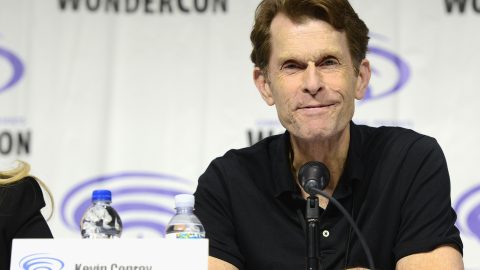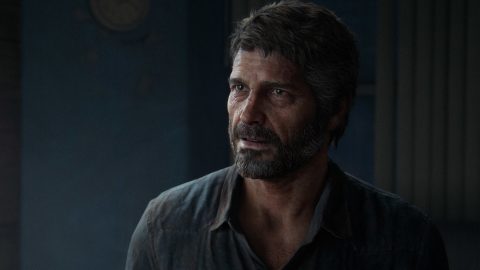
It’s been 15 years since spooky stop-motion epic Coraline first lured us into an uneasy ‘Other’ world filled with talking cats and evil, button-eyed Other Mothers – and we’re still not over it. Directed by The Nightmare Before Christmas helmer and all-round animation hero Henry Selick, this gleefully sinister adaptation of author Neil Gaiman’s novella of the same name gave kids the chills when it initially came out but in the years since it’s become a creepy cult classic.
Key to its extended shelf life is the movie’s ace score; a jingly, jangly, aural fairytale-with-teeth penned by French composer Bruno Coulais. It’s his dreamy notes that soundtrack young Coraline’s (Dakota Fanning) journey through a tiny door in her shadowy new home and into a too-good-to-be-true colourful alternative reality where she meets button-eyed doppelgangers of her own parents – versions who are so caring, it’s a little suspicious.
Utilising state-of-the-art 3D and game-changing model printing to bring his characters’ emotions to lush life, it’s no wonder Selick calls Coraline his most personal film to date. However, it’s Coulais’ mediative score that has helped to cement its legacy as one worth returning to time and time again.

Scoring Selick’s work was incredibly tricky
That said, creating such an ethereal soundtrack was easier said than done. As Selick is quick to point out, finding the right music to accompany his movies has never been easy. “It’s really tough,” he tells NME as Coraline returns to cinemas. “It’s the same challenge I’ve always faced with all of my work – it’s too scary for kids but not scary enough for adults – and [Coraline] was the same thing,” he says. “Whenever you’re looking for a composer, you look at different films and listen to what might be right. Animated films that are PG should be safe – and the music should kind of support that.”
Thankfully, it wasn’t long before Coulais caught Selick’s eye… or ear. “I just so happened to have seen a film by Bruno called Winged Migration,” says the director, recalling Coulais’ work on a 2001 documentary about migrating birds. “[Bruno] did all of the music and sound effects, and a colleague who had worked on Nightmare Before Christmas mentioned another nature movie [Bruno had worked on] called Microcosmos about the world of insects. We got the soundtracks to those movies, listened to them and it was just perfect,” remembers Selick. “I realised this is the guy.”

Bruno Coulais immediately knew the world of Coraline
Convinced he’d found the missing piece needed to bring Coraline’s world to life, Selick quickly set up a meeting with Coulias… but there was a problem. “His English wasn’t too strong and my French was horrible. During our first meeting, his brother translated,” laughs Selick. However, Coulais’ keen understanding of Coraline’s adventure was immediately apparent, despite the language barrier. “I felt like he connected with the truth of childhood,” adds the director, “that it’s magic and dangerous, sunny and dark.”
While Selick says that most animated films rely heavily on souped-up versions of temporary scores used to give early cuts dramatic heft, Coulais wasted no time jumping into Coraline’s headspace. “Bruno got involved early on and would do musical ‘sketches’ and themes for different characters. So many times he was so close right away. There was only one area where we had a disagreement: when Coraline saves her parents and thinks everything’s safe but it’s not,” says Selick, revealing how the pair crafted a key faux-ending sequence.
“I wanted it to feel more celebratory and he didn’t,” he continues. “At the last moment, when we were in the mixing stage, he wrote something on the piano. We recorded it and it went into the film. It gave me what I wanted but kept what he wanted,” adds Selick. “There was a hint that ‘no – it’s not over yet.’”
Still, there was one track where Selick took the reins: “I wrote the song that the two old ladies sing in the downstairs theatre,” he smiles, referencing the ‘Sirens On The Sea’ sequence. “I wrote the words and music and always expected him to write something better – but he said ‘No, it’s good!’ so it stayed in the film,” reveals Selick. “That’s my only musical contribution.”

It’s why Coraline is Selick’s all-time favourite
To mark its 15th birthday, Coraline has had a shiny 3D and 2D overhaul, with a remastered version revisiting cinemas for a limited time. Looking back, it’s easy to forget that while the film was a giant leap forward for the stop-motion medium, it was only a moderate hit with viewers upon its initial release. However, thanks to its stunning, labour-of-love visuals and Coulais’ delicately dreamy score, its audience has only grown, making it one of Selick’s most loved works to date.
“I’m probably the most proud of this film,” he says, speaking during a brief moment of downtime while working on his new stop-motion feature, an adaptation of Gaiman’s 2013 novel The Ocean At The End Of The Lane. “The film had its initial success but in the ensuing years, it’s become this interesting movement in society,” smiles Selick. “Kids find it and make their own costumes and people get [Coraline] tattoos… It’s like this growing child that finds ever larger audiences.”
‘Coraline’ is back in cinemas now
The post How ‘Coraline’s creepy-calming score became a dreamy cult classic appeared first on NME.






